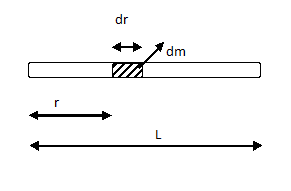Question
Question: A rod of length \(L\) rotates about an axis passing through one of its ends and perpendicular to its...
A rod of length L rotates about an axis passing through one of its ends and perpendicular to its plane. If the linear mass density of the rod varies as ρ=(Ar3+B)kg/m then find the moment of inertia of the rod about the given axis of rotation.
Solution
Linear mass density refers to the mass per unit length of an object. To find the moment of inertia of the rod view it as a collection of small particles/infinitesimals and find their mass(using the linear mass density) and position/distance from the axis to find their individual moment of inertia and then integrate under appropriate limits to find the moment of inertia of entire rod.
Formula Used:
The moment of inertia of a rod of length L rotating about an axis is given by, I=0∫Mdm⋅r2 where dm is the mass of a small element in the rod at a distance rfrom its end.
Complete step by step answer:
Step 1: Sketch a figure representing the rod and list the parameters given.

In the figure, we consider a small element of mass dm and length dr at a distance rfrom the end of the rod through which the rotating axis passes.
Given, the linear mass density of the rod is ρ=(Ar3+B)kg/m where A and B are constants and L is the length of the rod.
Step 2: Express the relation for the moment of inertia of the rod about an axis passing through one end of the rod and find its moment of inertia about that axis.
The moment of inertia of a rod of length L rotating about an axis passing through one end of the rod is given by, I=0∫Mdm⋅r2 ----------(1)
where dm is the mass of a small element in the rod at a distance rfrom its end.
The mass of the element of the rod can be expressed in terms of its linear density as dm=ρdr=(Ar3+B)dr .
Substituting for dm=(Ar3+B)dr in the equation (1) and changing the limits of the integral we get, I=0∫L(Ar3+B)r2dr
Simplifying the above integral we get, I=0∫L(Ar5+Br2)dr
Splitting the integrals and calculating we get, I=[6Ar6]0L+[3Br3]0L
Applying the limits in the above expression we get I=[6AL6]+[3BL3]
Simplifying we get, I=3L3(2AL3+B)
∴ the moment of inertia of the rod about the given axis is I=3L3(2AL3+B) .
Note: It is always important to break down any solid continuous body into small finite elements known as infinitesimals on which the equation for a particle can be applied and then integrate under proper limits to find the moment of inertia of the entire system of particles/continuous body.
